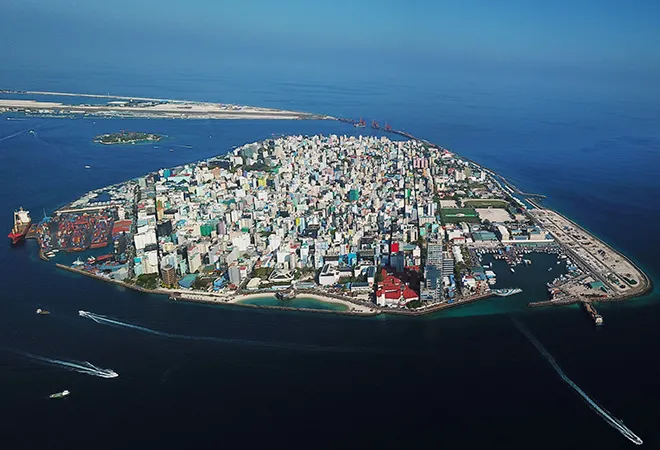
Small Island Developing States (SIDS) are recognised as 'climate change
hotspots’ due to current and future climate-related risks and thus face an existential crisis. According to the Intergovernmental Panel on Climate Change (IPCC),
SIDS will be the first and hardest hit by climate change, with several of these island nations projected to submerge due to rising sea levels. The then Maldivian President Mohamed Nasheed hosted an
underwater cabinet meeting in October 2009 in an emotional appeal to attract global focus to their plight. Nearly a decade-and-a-half since the Maldives' symbolic but loud and clear cry for help, SIDS have relentlessly tried to draw international attention to their fate.
Tourism and fisheries together contribute 40 percent of the Maldives’ GDP and employ 70 percent of the total population.
According to United Nations Environment Programme (UNEP) projections, the predicted sea-level rise of
0.5-0.8 metres will mean that Maldives will lose most of its land area by the year 2100. Maldives, being the
lowest-lying country in the world, with no
immediate neighbours on the mainland, a high population density, and an
over-reliance on climate-sensitive sectors such as tourism and fisheries to fuel its economy, is highly
vulnerable to climate change. Therefore, studying how climate change influences the Maldivian economy will help analyse the adaptation needs of different sectors and the effectiveness of existing measures and recognise future opportunities for action.
Economic risks
Climate change affects the economy’s primary, secondary, and tertiary sectors, leading to socio-economic and cultural impacts. Tourism and fisheries together
contribute 40 percent of the Maldives’ GDP and employ 70 percent of the total population. These sectors are vulnerable to climate events as 70-90 percent of tourism and fisheries infrastructure is within
100 metres of the coast. Due to their
proximity to the coast, trade and transportation infrastructures are vulnerable to sea-level rise, cyclones, and flooding. Damage to these infrastructures result in a loss of GDP and jobs and high reconstruction cost.
Threats of flooding, saltwater intrusion, unpredictable rainfall, and loss of transportation and communication routes affect food security. Furthermore, domestic cultivation of only a few subsistence crops explains Maldives' heavy dependence on food imports. Crop losses will impact women's livelihoods and marginalise them
further. Similarly, tuna, a critical foreign exchange earner for Maldives, accounting for 90 percent of its total fish
exports, is sensitive to temperature fluctuations.
The government will face a loss of tax revenues and loss of treasury due to the demand for aid or subsidies, impeding the creation of domestic jobs. Atolls, the ring-shaped islands with a saltwater lagoon in the middle, are tourism centres, which provide employment to the majority of the population and housing nearly 40 percent of the
nation’s poor. Subsequently, potential loss of employment will put additional pressure on the state’s resources, which are already burdened with a
highly dependent population, as seen during the COVID-19 pandemic. Additionally, the
low level of higher secondary education will accentuate multidimensional poverty and pressure on limited resources.
A critical foreign exchange earner for Maldives, accounting for 90 percent of its total fish exports, is sensitive to temperature fluctuations.
Also, climate change has threatened the projected revenue income from the major foreign-funded infrastructure projects, such as
Greater Malé Connectivity Project (GMCP),
Sinamale Bridge,
Hanimaadhoo International Airport and resort development on Feydhoo Finolhu Island, etc. The potential loss to these projects
imperils the country’s ability to repay its debt and
affects future investments. The questioning of the estimated return on investments in infrastructure projects jeopardises
insurance investments in risk-prone areas. However, notwithstanding these negative impacts, appropriate adaptation and mitigation measures can minimise climate change influence.
Climate adaptation
The tourism industry in Maldives is taking both soft and hard measures to
adapt to climate change. In 2011, the United Nations Educational, Scientific and Cultural Organization (UNESCO)
declared Baa Atoll a biosphere reserve, to protect coral reefs and biodiversity. This led to an upsurge in the island’s ecotourism industry. Maldives has witnessed a
large gap between policy and ground reality while adapting measures to increase resilience in the fight against climate change. The lack of concrete policy instruments, and the absence of climate-resilient building codes and funding are major issues. This requires co-financing from the industrial sector and multilateral institutions such as the World Bank, International Monetary Fund (IMF), World Trade Organization (WTO), United Nations Development Programme (UNDP), and Global Environment Facility (GEF), increasing the nation’s international debt.
Similarly, Maldives introduced the “no nets, rods or lines” policy for fishing and imposed a cap on the daily catch. It also joined the Indian Ocean Tuna Commission to bring fisheries to sustainable levels and adopted a resolution to preserve and manage the depleting
skipjack tuna stocks. The World Bank is
funding technical assistance to equip fishing vessels to locate fish and monitor distressed vessels. Likewise, farmers are using organic farming, rain-fed agriculture, climate-resistant crops, shade nets, and pot crops.
Programmes such as the
Green Smart Islands pilot project support organic farming and promote public knowledge and awareness of using organic fertilisers. A community-level
assessment of adaptive capacity in the fisheries and agriculture sectors found that low knowledge and awareness limit the adaptive capacity of fishers and farmers. Correspondingly, communities are adapting to circular, temporary, and seasonal
migration, but this is not possible for all.
Maldives has witnessed a large gap between policy and ground reality while adapting measures to increase resilience in the fight against climate change.
Additionally, Maldives took policy measures such as the First
and Second National Communication (SNC) submitted to the United Nations Framework Convention on Climate Change (UNFCCC) in 2001 and 2016, the National Adaptation Programme of Action (NAPA), and the Maldives Climate Change Policy Framework (MCCPF). The Coral Reef Research Programme, the Atoll Ecosystem Conservation Project, the Marine Research Centre, and the National Disaster Management Centre (NDMC) are also working on solutions. However, Maldives’
major shortcomings include limited government financing capacity, muted private sector engagement, a lack of commitment, and restricted capacity to raise international finance.
Maldives can address these gaps through an integrated national and international approach to improve the impact of adaptation actions.
Furthering adaptation measures
Such an integrated approach to fill the existing policy and adaptation gaps must include the following:
- Encourage more cross-country and cross-institutional collaborations to enhance financial and technical capacity. For instance, cooperation between Japan, UNDP, and Maldives on sustainable agriculture has improved Maldives’ organic farming potential.
- Provide more incentives to augment private sector investment in developing innovative solutions. The Netherlands-based Dutch Docklands floating city project has given new hope to Maldives to mitigate adverse impacts by providing re-settlement options for its population.
- Encourage environmental diplomacy through South-South Cooperation and the Alliance of Small Island States (AOSIS) to ensure insurance cover for the country’s policy of buying new homelands for its people in other countries to tackle the sovereignty and refugee rights issues of its citizens.
- Adapt global best practices to facilitate community participation in tourism, agriculture and fisheries. The cost-benefit analysis involving the local community in Germany’s coastal resort town of Timmendorfer Strand helped implement cost-effective adaptation measures using local resources. Similarly, training stakeholders through the Pacific Island Protected Area Portal (PIPAP) in producing maps of protected areas helped spread community awareness and reduce risks.
- Integrate climate change adaptation plans with national development planning and national budgeting for better situational analysis and addressing existing gaps. The World Bank study conducted on the Aqua Biodiversity Conservation project in Bangladesh showed the positive results of an integrated approach. The project proved to be cost-effective and resulted in higher fishery yields.
An integrated approach using national and international support and best practices can give better solutions to adapt and mitigate climate change impacts. An assessment of existing economic risks, adaptation measures, and efficacy of policy initiatives of small island nations can guide the required course of action. The recent 'landmark resolution'
adopted by the United Nations calling on the International Court of Justice (ICJ) to issue a legal advisory on climate change is a positive sign for environmental diplomacy of the Global South. The ICJ's advisory will set a precedent and give hope to the SIDS seeking international attention and cooperation to combat climate change.
Uzma Parveen was a research intern at ORF
The views expressed above belong to the author(s). ORF research and analyses now available on Telegram! Click here to access our curated content — blogs, longforms and interviews.



 Small Island Developing States (SIDS) are recognised as 'climate change
Small Island Developing States (SIDS) are recognised as 'climate change  PREV
PREV

